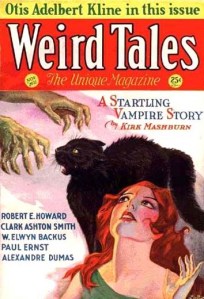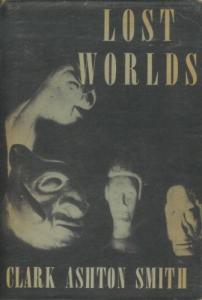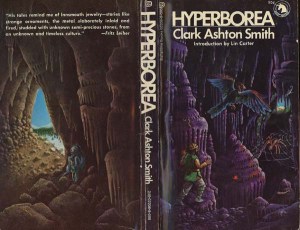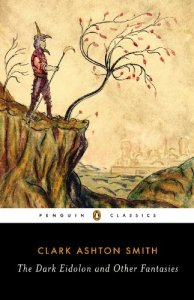If you were to stop someone on the street and ask them their favorite Clark Ashton Smith story, they would probably respond with something along the lines of, “Who?” Indeed, whenever I mention him in conversation this is the most common reply. This is a shame. Consider his reputation among other writers. H. P. Lovecraft wrote, “In sheer daemonic strangeness and fertility of conception, Clark Ashton Smith is perhaps unexcelled by any other writer dead or living.” The great Ray Bradbury said, “Take one step across the threshold of his stories and you plunge into color, sound, taste, smell, and texture – into language.” Jack Vance praised his “wild imagination.”
Smith (as has been mentioned on this blog before) was one of the “Big Three,” writers closely associated with the magazine Weird Tales. His writing is characterized by a vast and ornate vocabulary, his style often compared, not unrightly, to prose-poetry. His stories are often flavored with a sardonic humor that separates him from contemporaries such as Lovecraft. He was also an accomplished poet. “The Tale of Satampra Zeiros” was finished in 1929 and submitted to Weird Tales in 1930. At the time, it was rejected by editor Farnsworth Wright, but he reconsidered and published the story in November of 1931. Read it here.

The story is part of Smith’s Hyperborean cycle, a collection of tales set in the fictional prehistoric land of Hyperborea. These stories blend the cosmic horror of H. P. Lovecraft with the Iron Age settings of Robert E. Howard. The story concerns the thief Satampra Zeiros, who ventures to the long-abandoned city of Commoriom with his partner Tirouv Ompallios. Commoriom was once the capital of Hyperborea, and the thieves reason that there must be great treasures still buried there. Upon their arrival, however, they find that they should have stayed away.
In terms of plot, “Satampra Zeiros” is quite similar to Lord Dunsany’s “How Nuth Would Have Practised His Art Upon The Gnoles,” from The Book of Wonder (1912). Both tales focus on a master thief and his partner. Both begin with a summary of the master thief’s impressive exploits. Both concern a journey through a forest to a feared and abandoned locale supposedly stuffed with riches. And both end with one of the thieves meeting a horrible demise at the hands of the entities that dwell there.

Smith and Dunsany are also linked by their rich use of language. Smith’s description of the thieves’ journey to Commoriom through the jungle is gorgeous and evocative.
“Though the sun had not yet neared the horizon, the shades that were cast upon us from gigantic boles and branches became ever denser, and we moved in a dark-green twilight fraught with oppressive odors of lush growth and of vegetable corruption. There were no birds nor animals, such as one would think to find in any wholesome forest, but at rare intervals a stealthy viper with pale and heavy coils glided away from our feet among the rank leaves of the roadside, or some enormous moth with baroque and evil-colored mottlings flew before us and disappeared in the dimness of the jungle. Abroad already in the half-light, huge purpureal bats with eyes like tiny rubies arose at our approach from the poisonous-looking fruits on which they feasted, and watched us with malign attention as they hovered noiselessly in the air above.”
The similarities to Dunsany were recognized immediately. In his initial rejection letter to Smith, Farnsworth Wright wrote, “Personally, I fell under the spell of its splendid wording, which reminded me of Lord Dunsany’s stories in The Book of Wonder.” Smith also mailed a copy to his friend H. P. Lovecraft, who responded enthusiastically: “What an atmosphere! I can see & feel & smell the jungle around immemorial Commoriom… You have achieved in its fullest glamour the exact Dunsanian touch which I find almost impossible to duplicate.”

The story is also notable for its connection to the Cthulhu Mythos, a shared fictional universe based on creatures and concepts introduced in Lovecraft’s stories. The name derives from Lovecraft’s seminal weird tale “The Call of Cthulhu,” which I will be covering here later this year, and was coined by August Derleth, one of Lovecraft’s many correspondents and protégés. Specifically, “Satampra Zeiros” introduced the toad-god Tsathoggua, an entity which has appeared in the work of many Lovecraft-inspired authors since. However, due to the gap between the rejection and publication of “Satampra Zeiros,” this was not Tsathoggua’s first appearance in print. Lovecraft incorporated the deity into his 1930 story “The Whisperer in Darkness,” which was published in Weird Tales a mere three months before “Satampra Zeiros.”
“The Tale of Satampra Zeiros” has been republished many times over the decades. Among the more notable reprints, to me, are Smith’s 1944 short story collection Lost Worlds, published by Arkham House, and the 1971 Ballantine Adult Fantasy release Hyperborea, which collects the entire Hyperborean cycle into one volume. I read it in Penguin Classics’ The Dark Eidolon & Other Fantasies, a 2014 collection of Smith’s poetry and short fiction, edited by the renowned weird scholar S. T. Joshi.

Personally, after reading it I understood why Wright rejected it. Smith neglects to develop his characters beyond broad strokes, and I felt the ending to be quite abrupt. That being said, I also understood why Wright changed his mind. Smith’s writing is luscious, the setting of Hyperborea is intriguing, and the atmosphere he develops is palpable. It may not be his best story, but as an introduction to his work it does the job nicely.
NEXT TIME: “The Summer People” by Shirley Jackson!